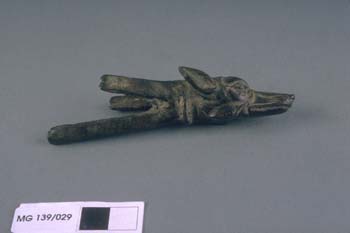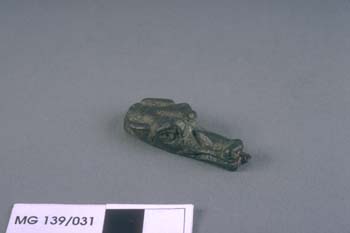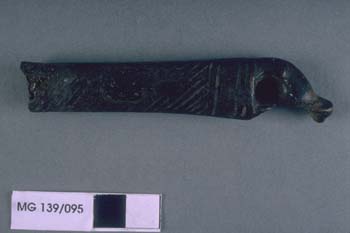| Author |
Message |
|
Harold R.
|
 Posted: Tue 21 Aug, 2007 3:49 pm Post subject: Langseax questions Posted: Tue 21 Aug, 2007 3:49 pm Post subject: Langseax questions |
 |
|
Lately I have become somewhat fascinated with viking and English history (in some part because of the writing of Bernard Cornwell).
As I understand it, this seax was found in the Thames river. http://www.myArmoury.com/view.html?features/pic_seax02.jpg
Does anyone know what its history is? What culture would it have "belonged" to? What time period?
Are there any smiths out there that could make a good "working" version of this langseax that won't require me to sell one of my kidneys to afford it?
|
|
   |
 |
|
Jeremy V. Krause
|
 Posted: Tue 21 Aug, 2007 5:32 pm Post subject: Posted: Tue 21 Aug, 2007 5:32 pm Post subject: |
 |
|
Hello Harold, and evereyone else!
I 've seen this blade before and it certainly is impressive. Does anyone know the date given to this specimen? Are those runic letters running doen the blade inscibed or inlayed? Very nice.
Ah, I went back and read the myArmoury article on the saex, which had some really beautiful pictures. It looks like this saex would likely date to the 8th or 9th century but maybe I am way off the mark.
,
Thanks,
Jeremy
|
|
  |
 |
Nathan Robinson
myArmoury Admin


|
|
    |
 |
|
Dustin R. Reagan
|
 Posted: Tue 21 Aug, 2007 7:20 pm Post subject: Posted: Tue 21 Aug, 2007 7:20 pm Post subject: |
 |
|
| Nathan Robinson wrote: | I took some less than stellar photos of this stellar seax while visiting the British Museum.
Here they are along with the catalog description from the museum.
|
Any idea on the dimensions; even approximately?
|
|
  |
 |
|
Harold R.
|
 Posted: Tue 21 Aug, 2007 8:00 pm Post subject: Posted: Tue 21 Aug, 2007 8:00 pm Post subject: |
 |
|
Thanks for the information. It is an awful lot more than I had to work with anyhow. I am thinking about trying to get something similar made but without the inscriptions.
Any idea on the dimensions? Looks like maybe about 24" blade or so and maybe 2" wide?
Any good smiths who work fairly cheap? Most of them seem to charge a whole lot (rightfully so I guess). But although their work is very nice, I tend to prefer the "rougher" versions anyhow.
|
|
   |
 |
Nathan Robinson
myArmoury Admin


|
 Posted: Tue 21 Aug, 2007 8:11 pm Post subject: Posted: Tue 21 Aug, 2007 8:11 pm Post subject: |
 |
|
According to The British Museum Web site, the seax is 81.1 cm long. That is 31.9 inches long.
| The British Museum wrote: |
Seax of Beagnoth
The only inscription of the complete Anglo-Saxon runic alphabet
Anglo-Saxon, 9th-10th century AD
From the River Thames at Battersea, London
The Old English word seax means 'knife', but is specifically used today to describe large Anglo-Saxon single-edged knives made of iron. This seax was found in the River Thames at Battersea.
A narrow panel of decoration runs along the back edge on each side of the blade. These panels are outlined by strips of twisted copper and brass wire and separated from the rest of the blade by a deep groove. On one side of the blade two inscriptions run along this panel.
One inscription is a copy of the twenty-eight letters of the runic alphabet, known as the futhorc. The other inscription, also in Anglo-Saxon runes, reads 'Beagnoth' which is the name of the person who owned or made the knife, something commonly found on these knives. The two inscriptions are here separated by a length of pattern made up of linked lozenges of silver and copper, and which takes up the entire length of the panel on the other side. The smith made mistakes in his runic alphabet and had to squeeze in a missing 's'.
Seaxes were weapons probably used in both combat and hunting. They are mainly found in the south of England.
|
.:. Visit my Collection Gallery :: View my Reading List :: View my Wish List :: See Pages I Like :: Find me on Facebook .:.
|
|
    |
 |
Thom R.

|
 Posted: Tue 21 Aug, 2007 8:30 pm Post subject: Re: Langseax questions Posted: Tue 21 Aug, 2007 8:30 pm Post subject: Re: Langseax questions |
 |
|
That is the famous one from Battersea, it is 72 cm long. It is uncommonly long and the runes are inlayed, and are a complete epigraphic series of the futhorc runes. At the far right after the non runic patterns is the name "Beagnoth", most likely either the maker or the owner of the seax. There are a few others that are almost as long, for example Northolt Manor Seax is 60 cm long. There are a few long seaxes found on the continent but most examples of > 50 cm have been found in England.
If you are interested in Anglo Saxon weaponry I would highly recommend "Anglo Saxon Weapons and Warfare" by Richard Underwood. It is an excellent reference. According to Underwood, the longer seaxes were developed in the 8th century in England, and are occasionally mentioned in wills. They are rarely mentioned in the epics and in accounts of battles. Therefore it is likely that the long seax was simply a Saxon version of a large hunting/utility knife, with some people having smaller ones, and some preferring (and could afford) to have big ones. They were carried horizontally in a sheath attached to a waist belt usually hanging right in front of the body. The blade cross section is usually very triangular making these big chopping knives. The Battersea seax has a very straight edge all the way to the point but many of the others have a curved edge in the last few inches before the point. The angle of the back edge seems to be quite variable
Last edited by Thom R. on Tue 21 Aug, 2007 9:12 pm; edited 1 time in total
|
|
  |
 |
Nathan Robinson
myArmoury Admin


|
|
    |
 |
Thom R.

|
 Posted: Tue 21 Aug, 2007 8:42 pm Post subject: Re: Langseax questions Posted: Tue 21 Aug, 2007 8:42 pm Post subject: Re: Langseax questions |
 |
|
I pulled out Gale and I stand corrected, for the Battersea he has 820 mm total, 640 mm blade and 180mm tang so the 81.1 is probably the correct length
Last edited by Thom R. on Tue 21 Aug, 2007 9:05 pm; edited 1 time in total
|
|
  |
 |
|
Harold R.
|
 Posted: Tue 21 Aug, 2007 8:50 pm Post subject: Posted: Tue 21 Aug, 2007 8:50 pm Post subject: |
 |
|
The smith made a mistake making it...
That is so cool !
|
|
   |
 |
Nathan Robinson
myArmoury Admin


|
|
    |
 |
Thom R.

|
 Posted: Tue 21 Aug, 2007 9:56 pm Post subject: Re: Langseax questions Posted: Tue 21 Aug, 2007 9:56 pm Post subject: Re: Langseax questions |
 |
|
I swear memory is one of the things that goes as I get older! There was a very interesting collection of seaxes from burials that were re-excavated in the 80s near my sisters house and I couldn't remember the name of the hoard but then after another guiness it finally came to me - the Butlers Field Hoard.
http://www.cotswold.gov.uk/nqcontent.cfm?a_id...ectId=4933
if the above link doesn't work google COTSWOLD Butler Field and I am sure you will find it. Its a very interesting collection because of the various items that were found, including sword pommels, shield bosses, jewelry, and knives and seaxes.
Most of the seaxes found there were 45-50 cm but there was one that was 687 mm which is quite large. The tang, proportionally, is much smaller than the Beagnoth seax. There are lots of great posts here in the archives on seaxes.
|
|
  |
 |
Thom R.

|
|
  |
 |
Luka Borscak

|
 Posted: Wed 22 Aug, 2007 3:26 am Post subject: Posted: Wed 22 Aug, 2007 3:26 am Post subject: |
 |
|
[/quote]
81cm is 32 inches...
|
|
  |
 |
Ville Vinje

|
 Posted: Wed 22 Aug, 2007 3:46 am Post subject: Posted: Wed 22 Aug, 2007 3:46 am Post subject: |
 |
|
| Harold R. wrote: |
Any good smiths who work fairly cheap? Most of them seem to charge a whole lot (rightfully so I guess). But although their work is very nice, I tend to prefer the "rougher" versions anyhow. |
Paul Binns made a blunted copy of the Battersea seax for a friend of mine. Paul used silver and copper for the inlays rather than copper and brass. Paul is relatively cheap and if it is "rougher" you want then Paul is your man.
http://www.paul-binns-swords.co.uk/index.htm
/Ville
|
|
   |
 |
Martin Wallgren

|
 Posted: Wed 22 Aug, 2007 4:30 am Post subject: Posted: Wed 22 Aug, 2007 4:30 am Post subject: |
 |
|
| Ville Vinje wrote: | | Harold R. wrote: |
Any good smiths who work fairly cheap? Most of them seem to charge a whole lot (rightfully so I guess). But although their work is very nice, I tend to prefer the "rougher" versions anyhow. |
Paul Binns made a blunted copy of the Battersea seax for a friend of mine. Paul used silver and copper for the inlays rather than copper and brass. Paul is relatively cheap and if it is "rougher" you want then Paul is your man.
http://www.paul-binns-swords.co.uk/index.htm
/Ville |
You wouldn´t happen to have a pic of would you? The copy I mean.That would be great!
Swordsman, Archer and Dad
|
|
    |
 |
|
Jeroen Zuiderwijk
Industry Professional
|
 Posted: Wed 22 Aug, 2007 5:11 am Post subject: Re: Langseax questions Posted: Wed 22 Aug, 2007 5:11 am Post subject: Re: Langseax questions |
 |
|
| Thom R. wrote: | | That is the famous one from Battersea, it is 72 cm long. It is uncommonly long and the runes are inlayed, and are a complete epigraphic series of the futhorc runes. At the far right after the non runic patterns is the name "Beagnoth", most likely either the maker or the owner of the seax. There are a few others that are almost as long, for example Northolt Manor Seax is 60 cm long. There are a few long seaxes found on the continent but most examples of > 50 cm have been found in England. |
Actually most longsaxes from the continent from the 8th century onwards are longer then 50cm, if you include the hilt (+50cm blade, plus 15-20cm tang is quite common). There's not many real longsaxes from England actually (at least that I'm aware off). I posted it before, but for those who haven't got it yet, I've got a big zip-file of sax data here: http://1501bc.com/files/information_about_saxes.zip
|
|
   |
 |
|
Jeroen Zuiderwijk
Industry Professional
|
 Posted: Wed 22 Aug, 2007 5:19 am Post subject: Posted: Wed 22 Aug, 2007 5:19 am Post subject: |
 |
|
| Ville Vinje wrote: | | Harold R. wrote: |
Any good smiths who work fairly cheap? Most of them seem to charge a whole lot (rightfully so I guess). But although their work is very nice, I tend to prefer the "rougher" versions anyhow. |
Paul Binns made a blunted copy of the Battersea seax for a friend of mine. Paul used silver and copper for the inlays rather than copper and brass. Paul is relatively cheap and if it is "rougher" you want then Paul is your man.
http://www.paul-binns-swords.co.uk/index.htm
/Ville |
The unfortunate thing is that he uses the wrong hilts. The hilts are antler instead of wood, and far too short. Re-enactors I know are complaining about the saxes, because their hand keeps slipping onto the blade, which would be much less likely if they had a proper hilt (20cm or longer getting wider towards the blade, tang glued in and no metal parts for most types of langsaxes).
|
|
   |
 |
|
Antoine M.
Industry Professional
Location: Trois-Rivières, Québec Joined: 17 Mar 2006
Posts: 34
|
 Posted: Wed 22 Aug, 2007 5:20 am Post subject: Posted: Wed 22 Aug, 2007 5:20 am Post subject: |
 |
|
Hi,
Jeroen, yes you posted that before and I forgot to thank you VERY MUCH for this!!!!
An exellent seax compendium!!
Antoine M.
my web site;
http://antoinemarcal.wordpress.com/
|
|
   |
 |
Thom R.

|
 Posted: Wed 22 Aug, 2007 7:51 am Post subject: Posted: Wed 22 Aug, 2007 7:51 am Post subject: |
 |
|
Somehow I had missed that compendium that is fantastic. Just recently I have been trying to research hilts for seax.
The hunt museum has some interesting pieces. this last one is definitely for a knife. not sure about the wolf mount, could be for a number of different things
 Attachment: 12.81 KB Attachment: 12.81 KB

 Attachment: 12.35 KB Attachment: 12.35 KB

 Attachment: 14.25 KB Attachment: 14.25 KB

|
|
  |
 |
|
|

